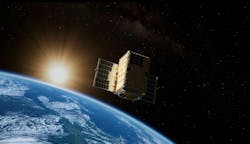Boeing announces launch window for tech that aims to bring quantum communications connectivity from space to Earth
EL SEGUNDO, Calif., - The Boeing Company in Arlington County, Va. announced plans to launch a satellite to test quantum entanglement swapping in space in 2026. The satellite, named Q4S, will be part of an experiment to explore quantum networking capabilities, according to the company's statement. Boeing says this technology can unlock applications across commercial, civil, and military sectors.
The mission, which is fully funded by Boeing, aims to advance the development of a secure, global quantum internet. Such an internet could connect quantum sensors and computers, technologies that are more precise and powerful than current systems.
Quantum sensors, capable of unprecedented precision, and quantum computers, known for processing vast data sets, could impact industries ranging from communications to national security. Boeing's experiment is designed to assess how quantum networks can be built across long distances while maintaining synchronization.
Related: NASA's 'ultra-cool' quantum sensor demonstrated aboard ISS
“We're making a big bet on quantum technology," said Jay Lowell, chief engineer for Boeing’s Disruptive Computing, Networks & Sensors division. "Quantum entanglement swapping underpins the communication of the future, expanding quantum networks beyond simple point-to-point communication. We're launching Q4S to prove it can be done in orbit."
Entanglement swapping, which relies on quantum teleportation, transfers information between particles over large distances without physically moving the particles themselves. Albert Einstein famously referred to this phenomenon as “spooky action at a distance,” highlighting its complexity.
“By demonstrating entanglement swapping, we can create a scalable network where quantum information can be transmitted over vast distances, something currently limited by decoherence and loss,” Lowell added.
If successful, quantum networking in space could lead to enhanced research capabilities, allowing scientists to gather new data on Earth and space environments. Current instruments are limited in sensitivity and resolution, and Boeing believes this mission could help overcome those barriers.
"Boeing has always served as a pioneer, pushing the boundaries of what's possible," said Todd Citron, Boeing's Chief Technology Officer. "We're doing much more than participating in quantum research; we are leading the way to operationalize and scale quantum technologies for global applications."
The Q4S mission will last for a year, featuring two entangled-photon pair sources housed on a space vehicle. Boeing’s technology partner, HRL Laboratories, has played a key role in advancing the project, particularly in preparing the space-hardened payload for launch.
